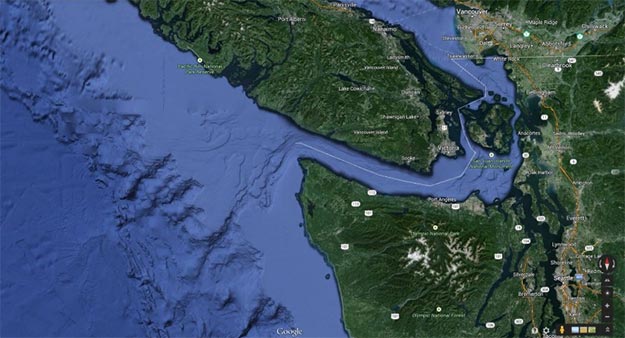The headwaters for Puget Sound’s famously rich waters lie far below the surface, in a submarine canyon that draws nutrient-rich water up from the deep ocean. New measurements may explain how the Pacific Northwest’s inland waters are able to support so many shellfish, salmon runs and even the occasional pod of whales.

The Juan de Fuca Canyon reaches the opening of the strait that separates the U.S. and Canada. The canyon is just under 4 miles wide and at least 450 yards deep, or twice the depth of the surrounding seafloor.
University of Washington oceanographers made the first detailed measurements at the headwater’s source, a submarine canyon offshore from the strait that separates the U.S. and Canada. Observations show water surging up through the canyon and mixing at surprisingly high rates, according to a paper published in March in Geophysical Research Letters.
“This is the headwaters of Puget Sound,” said co-author Parker MacCready, a UW professor of oceanography. “That’s why it’s so salty in Puget Sound, that’s why the water is pretty clean and that’s why there’s high productivity in Puget Sound, because you’re constantly pulling in this deep water.”
It has been known for decades that 20 to 30 times more deep water flows into Puget Sound than from all the rivers combined. Surface tides, while dramatic, play a minor role.
“The tidal currents that slosh the water back and forth, that’s what’s really obvious,” MacCready said. “But there’s also a slow, persistent circulation that is constantly bringing deep water in, mixing it up and sending the surface water out.”
The Juan de Fuca Canyon reaches the opening of the strait that separates the U.S. and Canada. The canyon is just under 4 miles wide and at least 450 yards deep, or twice the depth of the surrounding seafloor.
New measurements show this canyon potentially supplies most of the water coming into Puget Sound, the Strait of Juan de Fuca and Canada’s Georgia Strait.
The intense flow and mixing measured inside the canyon could help explain the mysterious productivity of Northwest shores. Coastal winds usually bring nutrients up on the west coast, but the numbers don’t add up for this region.
“Washington is several times more productive — has more phytoplankton — than Oregon or California, and yet the winds here are several times weaker. That’s been kind of a puzzle, for years,” said co-author Matthew Alford, an oceanographer with the UW’s Applied Physics Laboratory.
The secret to the Northwest’s outsize productivity could be marine canyons, an idea first suggested by UW oceanographer Barbara Hickey. The northern section of the west coast has many more canyons than Oregon or California, with 11 along the Washington coast.
The new paper provides the latest evidence for these canyons’ importance. Measurements by another UW oceanographer in the 1970s first showed water flowing through Juan de Fuca Canyon with a direction that depends on the coastal winds. More recently, calculations by Hickey and a colleague in 2008 suggested submarine canyons could play an important role in supplying nutrients to the Northwest coastal waters.
Alford and MacCready measured inside the Juan de Fuca Canyon in April 2013 using an instrument, built at the UW Applied Physics Laboratory with funding from Washington Sea Grant, that takes water measurements near the seafloor. During a day and a half of round-the-clock observations they got lucky with the wind direction and recorded strong flow up through the canyon.
Water flowed as fast as 1.3 feet per second at 500 feet below the surface, and showed mixing up to 1,000 times the normal rate for the deep ocean. The data also showed that the flow is hydraulically-controlled, meaning it flows smoothly over a shallow ridge just off the cape and then forms a turbulent breaking wave on the other side, mixing with the waters far above.
The deep water forced up through the canyon is rich in nutrients that support the growth of marine plants which then feed other marine life. Those waters also are more acidic and lower in oxygen, all of which contribute to water conditions in the Sound.
“The location of this sill would be an outstanding place to fish,” Alford said. “People fish in Juan de Fuca Canyon pretty actively, and that’s probably no coincidence.”
Pinpointing the source of Puget Sound waters will help make better computer models of circulation through the region, and eventually could help forecast ocean acidity, harmful algal blooms and low-oxygen events.
“Canyons might be important not just for coastal productivity, but that mixed water also gets exported into the interior of the ocean,” Alford said. “I look at this as a first step in getting canyons right in coastal models and in global climate models, because I think it could potentially be a very important source of mixing.”
The research was funded by the Office of Naval Research and the National Oceanic and Atmospheric Administration. Ship time aboard the Thomas G. Thompson was provided by the UW.
Source: http://www.sciencedaily.com
Dear User/Visitor! Please, answer on our questions: tick off one of the positions – your answer will make us able to improve our site and make it more interesting and useful!

